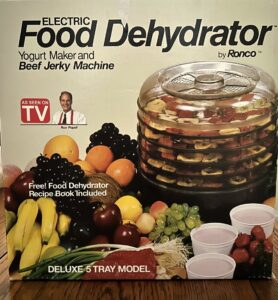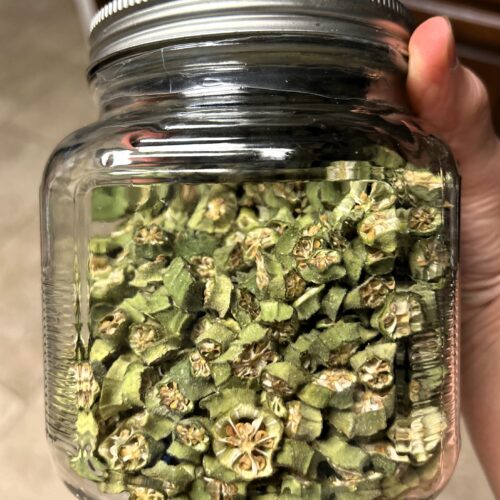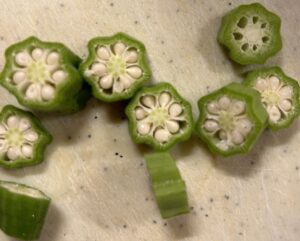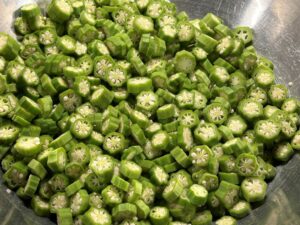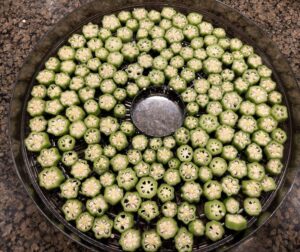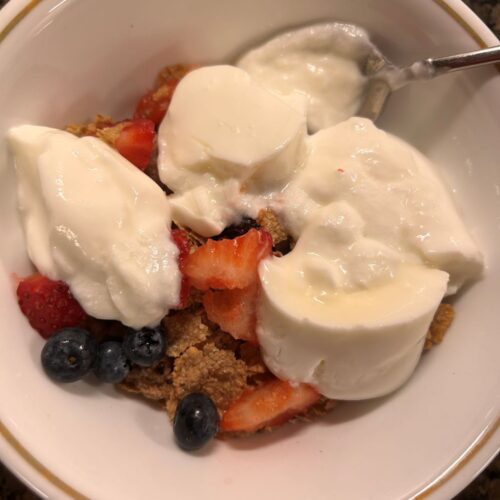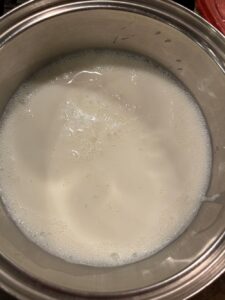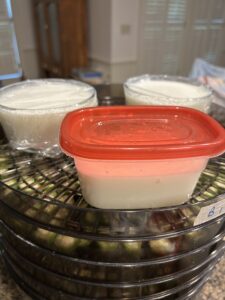With memories over time some details fade from your mind and when you try to recall it you might not remember the whole story. I just want to remind the family genealogist the importance of recording events. So the jist of this memory is that some good friends of my husband’s parents gave it to my husband as he love their beef jerky that they made. I guess he ate a lot of their jerky.
Anyway, I know we got the “As Seen On T.V.” dehydrator when we lived in Michigan in the early 1990’s and I did use it to make beef jerky, but beef is expensive so I have not made it in years. I knew exactly where the dehydrator was located in my large cabinet above the refrigerator.
Our Dehydrator
How we got started on drying okra was by a recipe my son-in-law’s cousin texted to me to see if I was interested in trying it. The original recipe said to dehydrate at 125 for 4 hours. Well, they must have a fancier dehydrator as mine said it would take a few days.
Would you believe I still have the original box for my dehydrator? Yes, and in this post, I will not only give you my second okra recipe, but the beef jerky recipe as well as my yogurt recipe. Each one uses the dehydrator, after all.
So if you like beef jerky here is my recipe:
Nancy's Beef Jerky
Equipment
- Dehydrator
- Sharp Knife
- Glass container or Ziplock closure bags
- Liquid measurer
- Measuring spoons
Ingredients
- 4 pounds of round steak 1-1 1/2 inches thick
- 4 teaspoons liquid smoke
- 2 teaspoons garlic powder
- 2 teaspoons onion powder
- 2 Teaspoons chili powder
- 1/4 cup Worcestershire sauce
- 1 cup soy sauce
Instructions
- Trim all visible fat from meat. Partially freeze to make slicing easier. Slice with the grain 1/8 to 1/4 inch wide and 4 to 12 inches long.
- Combine all remaining ingredients. Mix with beef strips place in either a glass dish or use gallon ziplock bags. Refrigerate 8 hours or overnight.
- Lay beef strips in single layers on the dehydrator rack. Follow your manufactor's directions.
- Dry until the desired leathery jerky texture. Dry time will vary. My Ronco 5 tray food dehydrator could take 1-2 days, but go by how leathery jerky texture you want.
- With a papertowel blot any drops of oil from the jerky.
- Place in an airtight container and store in the refrigerator or freezer.
Notes
- If you do not have a dehydrator, lay beef strips in single layers on oven racks with cookie sheets or something to catch the drippings. Bake at 140-150F for 10-15 hours or until desired leathery jerky texture.
- If you have a vacuum sealer, it will remove the air and create an airtight seal, which helps preserve the jerky.
Now to the real reason for this post; using my dehydrator for too much okra from the Pickle Patch.
Dried Okra
Equipment
- Salad spinner or something to rinse okra
- Cutting Board
- Sharp Knife
- Large Bowl
- Rubber Spatula
- Dehydrator
Ingredients
- 2 1/2-3 Pounds Okra
- 1 Tablespoon Garlic Salt Your favorite brand or make your own (see notes)
Instructions
- Rinse okra and shake to get most of the water off. Or spin if using a salad spinner.
- Using a sharp knife slice okra in 1/4 inch slices.
- Sprinkle garlic salt on gradually, stirring to distribute the garlic salt.
- Arrange okra slices 1 layer thick on your dehydrator trays.
- Follow the instructions for your dehydrator.
Notes
- The substitute for garlic salt is 3 teaspoons salt and 1 teaspoon of garlic powder. I make my own as I usually have these two ingredients and only a few recipes call for garlic salt.
- I numbered my dehydrator trays 1-5 to be able to rotate them like the directions in the dehydrator book.
- For giving as gifts and general storing I use a FoodSaver vacuum food sealer to keep them fresh longer.
Yogurt
Equipment
- Stainless steel pot
- Food thermometer
- Whisk
- 4-cup liquid measurer
- 1/2-cup dry measuring cup
- Ladle
- Containers for yogurt
Ingredients
- 1 Quart or 4 cups Milk Your choice of percent fat.
- 1/2 Cup Plain yogurt That lists live active bacteria.
Instructions
- Heat the milk to just under the boiling point in a stainless steel pan. Small bubbles will appear around the edge of the liquid when it reaches this point.
- Remove from heat and set aside to cool somewhat.
- When the milk is just reaching lukewarm temperature, about 100°F, stir in the yogurt using the whisk.
- Ladle in containers that fit in the top tray of your dehydrator.
- Allow yogurt to rest, undisturbed for about 8 hours.
- Do not move containers while the bacteria are at work or the yogurt may not set.
- Once done store the containers in the refrigerator.
Notes
- To make yogurt with my dehydrator I put the containers of yogurt that has to fit on the top shelf with dome lid. You know my book is old when they suggest to use margarine containers. I have 2 small glass containers and one plastic storage container that fits exactly in the space.
Getting Carried Away
You might be thinking I got too carried away with the three recipes, when it was supposed to be how to dry okra, but I felt they tied in nicely. Food plays an important part of who I am. My Grandma Mews had a big part in it. My sisters and I spent many sleepovers at our grandparents’ house, where we learned a lot about cooking. Sometimes a new recipe brings back memories I have long forgotten.
Some recipe memories are triggered by something like me getting the old dehydrator out to make dried okra, and others happen because of thinking of loved ones that are gone. It is always good to capture the memories or recipes in your tree.
If I ever print out my tree the Nancy Dru chapter will be long as there will be many stories about recipes and gardening, two passions that define who I am. I do have another okra recipe and will post it at a later date, as I want to blog about our new addition next.

